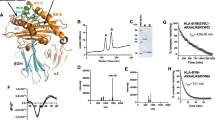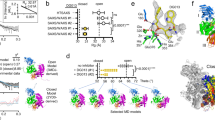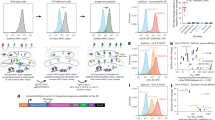Abstract
Endoplasmic reticulum (ER) aminopeptidase 1 (ERAP1) appears to be specialized to produce peptides presented on class I major histocompatibility complex molecules. We found that purified ERAP1 trimmed peptides that were ten residues or longer, but spared eight-residue peptides. In vivo, ERAP1 enhanced production of an eight-residue ovalbumin epitope from precursors extended on the NH2 terminus that were generated either in the ER or cytosol. Purified ERAP1 also trimmed nearly half the nine-residue peptides tested. By destroying such nine-residue peptides in normal human cells, ERAP1 reduced the overall supply of antigenic peptides. However, after interferon-γ treatment, which causes proteasomes to produce more NH2-extended antigenic precursors, ERAP1 increased the supply of peptides for MHC class I antigen presentation.
This is a preview of subscription content, access via your institution
Access options
Subscribe to this journal
Receive 12 print issues and online access
$259.00 per year
only $21.58 per issue
Buy this article
- Purchase on SpringerLink
- Instant access to full article PDF
Prices may be subject to local taxes which are calculated during checkout




Similar content being viewed by others
References
York, I.A., Goldberg, A.L., Mo, X.Y. & Rock, K.L. Proteolysis and class I major histocompatibility complex antigen presentation. Immunol. Rev. 172, 49–66 (1999).
Rock, K.L., York, I.A., Saric, T. & Goldberg, A.L. Protein degradation and the generation of MHC class I-presented peptides. Adv. Immunol. 80, 1–70 (2002).
Shastri, N., Schwab, S. & Serwold, T. Producing nature's gene-chips: the generation of peptides for display by MHC class I molecules. Annu. Rev. Immunol. 20, 463–493 (2002).
Goldberg, A.L., Cascio, P., Saric, T. & Rock, K.L. The importance of the proteasome and subsequent proteolytic steps in the generation of antigenic peptides. Mol. Immunol. 1169, 1–17 (2002).
Kisselev, A.F., Akopian, T.N., Woo, K.M. & Goldberg, A.L. The sizes of peptides generated from protein by mammalian 26 and 20S proteasomes. Implications for understanding the degradative mechanism and antigen presentation. J. Biol. Chem. 274, 3363–3371 (1999).
Craiu, A., Aklopian, T., Goldberg, A.L. & Rock, K.L. Two distinct proteolytic processes in the generation of a major histocompatibility complex class I-presented peptide. Proc. Natl. Acad. Sci. USA 94, 10850–10855 (1997).
Mo, X.Y., Cascio, P., Lemerise, K., Goldberg, A.L. & Rock, K. Distinct proteolytic processes generate the C and N termini of MHC class I-binding peptides. J. Immunol. 163, 5851–5859 (1999).
Beninga, J., Rock, K.L. & Goldberg, A.L. Interferon-γ can stimulate post-proteasomal trimming of the N terminus of an antigenic peptide by inducing leucine aminopeptidase. J. Biol. Chem. 273, 18734–18742 (1998).
Saric, T. et al. Major histocompatibility complex class I-presented antigenic peptides are degraded in cytosolic extracts primarily by thimet oligopeptidase. J. Biol. Chem. 276, 36474–36481 (2001).
Stoltze, L. et al. Generation of the vesicular stomatitis virus nucleoprotein cytotoxic T lymphocyte epitope requires proteasome-dependent and –independent proteolytic activities. Eur. J. Immunol. 28, 4029–4036 (1998).
Fruci, D., Niedermann, G., Butler, R.H. & van Endert, P.M. Efficient MHC class I-independent amino-terminal trimming of epitope precursor peptides in the endoplasmic reticulum. Immunity 15, 467–476 (2001).
Stoltze, L. et al. Two new proteases in the MHC class I processing pathway. Nature Immunol. 1, 413–418 (2000).
Elliott, T., Willis, A., Cerundolo, V. & Townsend, A. Processing of major histocompatibility class I-restricted antigens in the endoplasmic reticulum. J. Exp. Med. 181, 1481–1491 (1995).
Lobigs, M., Chelvanayagam, G. & Mullbacher, A. Proteolytic processing of peptides in the lumen of the endoplasmic reticulum for antigen presentation by major histocompatibility class I. Eur. J. Immunol. 30, 1496–1506 (2000).
Snyder, H.L., Yewdell, J.W. & Bennink, J.R. Trimming of antigenic peptides in an early secretory compartment. J. Exp. Med. 180, 2389–2394 (1994).
Snyder, H.L., Bacik, I., Yewdell, J.W., Behrens, T.W. & Bennink, J.R. Promiscuous liberation of MHC-class I-binding peptides from the C termini of membrane and soluble proteins in the secretory pathway. Eur. J. Immunol. 28, 1339–1346 (1998).
Roelse, J., Gromme, M., Momburg, F., Hammerling, G.J. & Neefjes, J.J. Trimming of TAP-translocated peptides in the endoplasmic reticulum and in the cytosol during recycling. J. Exp. Med. 180, 1591–1597 (1994).
Paz, P., Brouwenstijn, N., Perry, R. & Shastri, N. Discrete proteolytic intermediates in the MHC class I antigen processing pathway and MHC I-dependent peptide trimming in the ER. Immunity 11, 241–251 (1999).
Brouwenstijn, N., Serwold, T. & Shastri, N. MHC class I molecules can direct proteolytic cleavage of antigenic precursors in the endoplasmic reticulum. Immunity 15, 95–104 (2001).
Komlosh, A. et al. A role for a novel luminal endoplasmic reticulum aminopeptidase in final trimming of 26 S proteasome-generated major histocompatability complex class I antigenic peptides. J. Biol. Chem. 276, 30050–30056 (2001).
Momburg, F., Neefjes, J.J. & Hammerling, G.J. Peptide selection by MHC-encoded TAP transporters. Curr. Opin. Immunol. 6, 32–37 (1994).
Lauvau, G. et al. Human transporters associated with antigen processing (TAPs) select epitope precursor peptides for processing in the endoplasmic reticulum and presentation to T cells. J. Exp. Med. 190, 1227–1240 (1999).
Serwold, T., Gaw, S. & Shastri, N. ER aminopeptidases generate a unique pool of peptides for MHC class I molecules. Nature Immunol. 2, 644–651 (2001).
Knuehl, C. et al. The murine cytomegalovirus pp89 immunodominant H-2Ld epitope is generated and translocated into the endoplasmic reticulum as an 11-mer precursor peptide. J. Immunol. 167, 1515–1521 (2001).
Saric, T. et al. ERAP1, an interferon γ-induced aminopeptidase in the endplasmic reticulum, that trims precursors to MHC class I-presented peptides. Nature Immunol. 3, 1169–1176 (2002).
Hattori, A., Matsumoto, H., Mizutani, S. & Tsujimoto, M. Molecular cloning of adipocyte-derived leucine aminopeptidase highly related to placental leucine aminopeptidase/oxytocinase. J. Biochem. (Tokyo) 125, 931–938 (1999).
Schomburg, L., Kollmus, H., Friedrichsen, S. & Bauer, K. Molecular characterization of a puromycin-insensitive leucyl-specific aminopeptidase, PILS-AP. Eur. J. Biochem. 267, 3198–3207 (2000).
Serwold, T., Gonzalez, F., Kim, J., Jacob, R. & Shastri, N. ERAAP customizes peptides for MHC class I molecules in the endoplasmic reticulum. Nature 419, 480–483 (2002).
Cascio, P., Hilton, C., Kisselev, A.F., Rock, K.L. & Goldberg, A.L. 26S proteasomes and immunoproteasomes produce mainly N-extended versions of an antigenic peptide. EMBO J. 20, 2357–2366 (2001).
Elbashir, S.M. et al. Duplexes of 21-nucleotide RNAs mediate RNA interference in cultured mammalian cells. Nature 411, 494–498 (2001).
Porgador, A., Yewdell, J.W., Deng, Y. Bennink, J.R. & Germain, R.N. Localization, quantitation, and in situ detection of specific peptide-MHC class I complexes using a monoclonal antibody. Immunity 6, 715–726 (1997).
Rammensee, H.-G., Friede, T. & Stefanovic, S. MHC ligands and peptide motifs: first listing. Immunogenetics 41, 178–228 (1995).
Lucchiari-Hartz, M. et al. Cytotoxic T lymphocyte epitopes of HIV-1 Nef: Generation of multiple definitive major histocompatibility complex class I ligands by proteasomes. J. Exp. Med. 17, 239–252 (2000).
Gaczynska, M., Rock, K.L. & Goldberg, A.L. γ-interferon and expression of MHC genes regulate peptide hydrolysis by proteasomes. Nature 365, 264–267 (1993).
Driscoll, J., Brown, M.G., Finlay, D. & Monaco, J.J. MHC-linked LMP gene products specifically alter peptidase activities of the proteasome. Nature 365, 262–264 (1993).
Ahn, J.Y. et al. Primary structures of two homologous subunits of PA28, a γ-interferon-inducible protein activator of the 20S proteasome. FEBS Lett. 366, 37–42 (1995).
Whitby, F.G. et al. Structural basis for the activation of 20S proteasomes by 11S regulators. Nature 408, 115–120 (2000).
Cascio, P., Call, M., Petre, B.M., Walz, T. & Goldberg, A.L. Properties of the hybrid form of the 26S proteasome containing both 19S and PA28 complexes. EMBO J. 21, 2636–2645 (2002).
Kohler, A. et al. The axial channel of the proteasome core particle is gated by the Rpt2 ATPase and controls both substrate entry and product release. Mol. Cell 7, 1143–1152 (2001).
Restifo, N.P. et al. Antigen processing in vivo and the elicitation of primary cytotoxic T lymphocyte responses. J. Immunol. 154, 4414–4422 (1995).
O'Neil, B.H. et al. Detection of shared MHC-restricted human melanoma antigens after vaccinia virus-mediated transduction of genes coding for HLA. J. Immunol. 151, 1410–1418 (1993).
Hattori, A. et al. Characterization of recombinant human adipocyte-derived leucine aminopeptidase expressed in Chinese hamster ovary cells. J. Biochem. (Tokyo) 128, 755–762 (2000).
Parham, P., Barnstable, C.J. & Bodmer, W.F. Use of a monoclonal antibody (W6/32) in structural studies of HLA-A,B,C antigens. J. Immunol. 123, 342–349 (1979).
Parham, P. & Bodmer, W.F. Monoclonal antibody to a human histocompatibility alloantigen, HLA-A2. Nature 276, 397–399 (1978).
Stam, N.J., Spits, H. & Ploegh, H.L. Monoclonal antibodies raised against denatured HLA-B locus heavy chains permit biochemical characterization of certain HLA-C locus products. J. Immunol. 137, 2299–2306 (1986).
Laemmli, U.K. Cleavage of structural proteins during the assembly of the head of bacteriophage T4. Nature 227, 680–685 (1970).
Acknowledgements
We thank R. Welsh, M. Brehm, T. Vedvick and particularly L. Selin for the gifts of synthetic peptides; A. Hattori and M. Tsujimoto for recombinant ERAP1; L. Stern and B. Scearce for helpful discussions; and S. Trombley for assistance in preparing this manuscript. Supported by grants from the NIH (to K. L. R. and A. L. G.).
Author information
Authors and Affiliations
Ethics declarations
Competing interests
The authors declare no competing financial interests.
Rights and permissions
About this article
Cite this article
York, I., Chang, SC., Saric, T. et al. The ER aminopeptidase ERAP1 enhances or limits antigen presentation by trimming epitopes to 8–9 residues. Nat Immunol 3, 1177–1184 (2002). https://doi.org/10.1038/ni860
Received:
Accepted:
Published:
Issue date:
DOI: https://doi.org/10.1038/ni860
This article is cited by
-
Immune escape of head and neck cancer mediated by the impaired MHC-I antigen presentation pathway
Oncogene (2024)
-
HLA-B*27 and Ankylosing Spondylitis: 50 Years of Insights and Discoveries
Current Rheumatology Reports (2023)
-
Alanine-based spacers promote an efficient antigen processing and presentation in neoantigen polypeptide vaccines
Cancer Immunology, Immunotherapy (2023)
-
Markers of immune dysregulation in response to the ageing gut: insights from aged murine gut microbiota transplants
BMC Gastroenterology (2022)
-
ERAP1 is a critical regulator of inflammasome-mediated proinflammatory and ER stress responses
BMC Immunology (2022)



